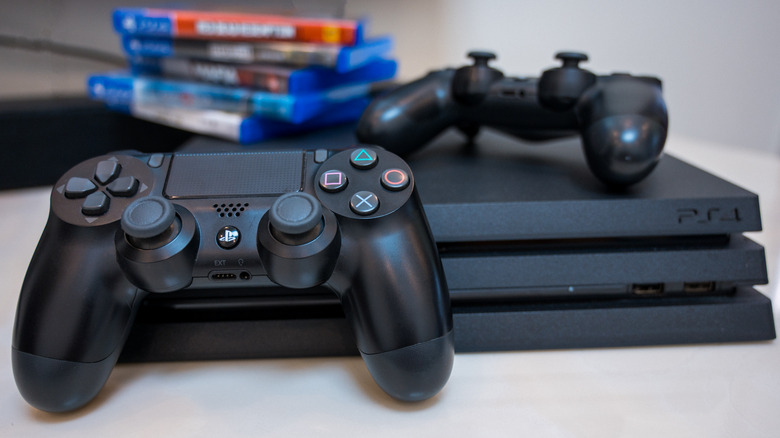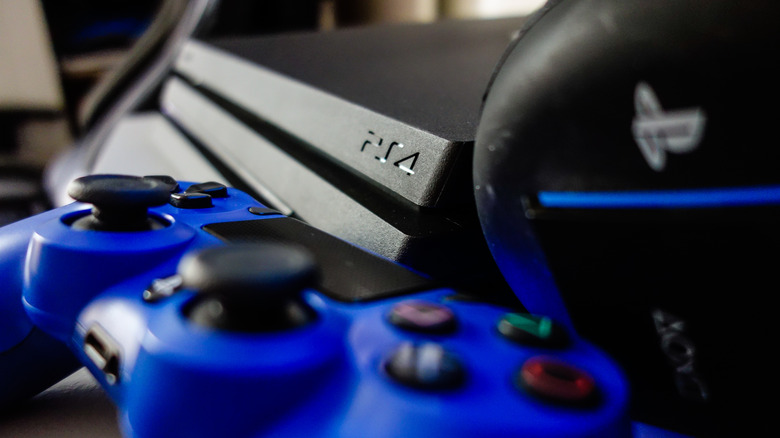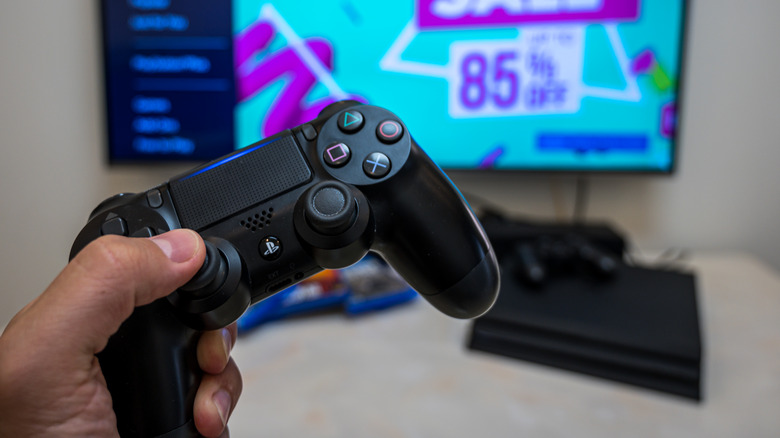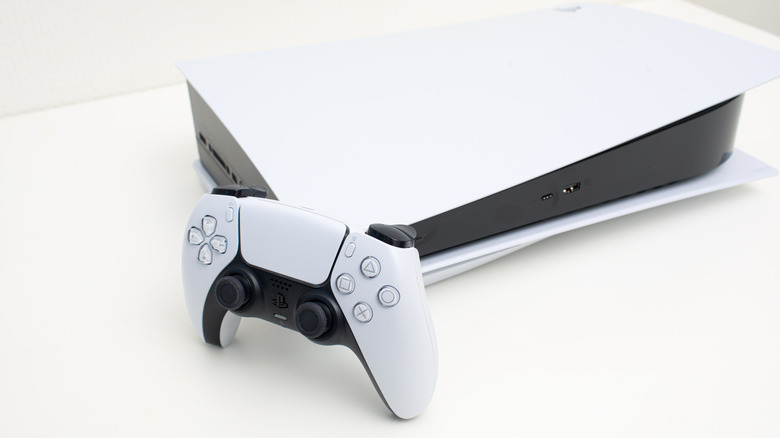Is Your PlayStation 4 Overheating? Here Are 5 Ways To Fix It
Since it launched in 2013, the PlayStation 4 has been a beloved addition in many gamers' households. When it was first released, the fourth generation of the console arrived with top-of-the-line graphics and an exclusive library filled with exciting titles that would eventually become core memories for gamers of all ages. Not to mention, aside from the console itself, it came with the PS4 DualShock Controller that still tops our list of the best controllers of all time. It's no wonder that, for the most part, the PlayStation 4 console has stood the test of time. That is, of course, when it's not broken.
If you've had your PlayStation 4 console for over a decade, it's unsurprising that it may have developed a few issues along the way, such as messaging bugs or corrupted data. However, one common concern that many PS4 owners have experienced at some point is overheating. The first (and most obvious) clue that your console is overheating is when it literally pulls up a "The PS4 is too hot" notification on the blue screen. However, aside from this, there are several other signs of overheating that you might have missed, which could spell disaster for your PS4's longevity. Here are a few that you should know about, so you can manage it before it causes any trouble.
Signs your PlayStation 4 is overheating
Another way to know if your PS4 is starting to burn up is simply by touch. In the early stages of overheating, an unusually high temperature may not be as obvious as you think. Typically, Sony notes that the PlayStation 4 can operate up to 95 degrees Fahrenheit (35 degrees Celsius), which is actually a few degrees lower than the average human body temperature. It might not be immediately obvious that it's not cooling the way it should.
Other clues that your PS4 is burning hotter than normal include your games acting a little wonky. Sometimes, it can appear like the assets aren't loading properly or suddenly freezing. It's important to note that there could be plenty of other reasons why your games are crashing, like an issue with the game itself or not being connected to Wi-Fi. In some cases, when your PS4 is overheating, you'll even be treated to the annoying sound of a clunky, spinning fan.
Regardless of the reason, keeping your PS4 running above the standard operating temperature can lead to disastrous consequences. Apart from making it impossible to play your favorite games, it can also damage the internal components and ruin it for good. So, if you're keen on keeping your PS4 running better for longer, here are all the ways you can bring it back to normal temperature.
Improve the ventilation
When your PlayStation 4 starts running too hot, keeping it cool (literally) should be your priority. To do this, you'll want to increase the airflow as much as possible, which you can do by improving the overall ventilation. In its PS4 Pro Safety Guide [PDF], Sony shares tips on how to keep vents working properly, such as not putting the console on carpets (or heat-trapping surfaces) and not covering it with cloth. In addition, it recommends not storing it in tight areas, specifically allotting at least 10 cm in space away from the nearest wall.
Aside from where you put your PlayStation console, it's important to note that how clear the vent is can also impact how much air can pass through it. So, if you haven't already, make sure to give your PlayStation vents (and the rest of it) a good cleaning. Before you start to clean the external portion of your PS4, make sure it's unplugged and turned off to avoid accidents. Then, use a can of compressed air to blow the dust away and a dry microfiber cloth to remove them completely.
While you're in the process of making sure your console airflow is all good, you should also make sure that your PS4 isn't placed in a hot location, such as near a window with direct sunlight. Lastly, you can consider getting additional temperature regulating accessories, like an external fan, for some added peace of mind.
Update your games
Have you considered that your game could be the problem? In 2017, Rainbow Siege caused quite a stir when it was reported to go as far as corrupting the PS4 hard drive. Two years later, many users also experienced their PS4s turning off by itself because of software errors and other issues after launching Anthem, an online multiplayer game. Thankfully, once developers are alerted of game-related overheating issues, a patch or software update will be released to fix it as soon as possible.
In general, the PlayStation 4 console is designed to automatically download new game updates when it can. However, download errors can occur, which can sometimes be due to not enough storage or unstable internet connections. If this happened to you, here's how to manually update games on your PS4.
-
Launch your PlayStation 4 and navigate to the main menu.
-
Using your PS4 DualShock Controller, hover over the game/s you suspect is causing your overheating issues.
-
On your DualShock Controller, press the Options button.
-
In the right sidebar, select Check for Update. If an update is available, you'll be able to see the text "An update for this application is available."
-
Select Go to [Downloads].
-
In the Downloads section, select the game you want to update > Resume.
Advertisement
Alternatively, if you're aware that developers have still not resolved the bugs causing the overheating issue, you can opt to select Cancel and Delete instead. Afterward, you can re-install it again when it won't cause problems.
Update your PlayStation console software
Through the years, Sony has sent dozens of updates to its consoles, whether it is to improve security or performance, including to solve overheating problems. Typically, your PlayStation console will inform you that it's due for a software update via notification. However, if you've actively ignored this or encountered issues with the process, you can easily check for updates and do it manually.
-
Launch your PlayStation 4 and navigate to your main menu.
-
Press the arrow up button on your PS4 DualShock controller.
-
In the right section of the screen, select the Settings app.
-
Select System Software Update.
And if you want to make sure you never miss an update again, return to the Settings app and go to System > Automatic Downloads. Alternatively, you can also manually update your PS4 using a USB. Here's how.
-
On your computer, go to the PlayStation website.
-
Click PS4 console update file.
-
Wait for the "PS4UPDATE.PUP" to finish downloading.
-
Plug a FAT32 or exFAT formatted USB to your computer.
-
In the USB, create a folder named "UPDATE" in all capital letters.
-
Transfer the "PS4UPDATE.PUP" file inside it by copying and pasting.
Advertisement -
Plug the USB with the "PS4UPDATE.PUP" file into your PS4.
-
Long press the PlayStation 4 power button. After you hear the second beep, this means it is launched in Safe Mode.
-
Using your PS4 Controller, select Update System Software.
-
Select Update from USB Storage Device.
-
Select OK and wait for the update to finish.
Send it for repair
Unfortunately, when it comes to older devices, it's not uncommon for parts to break from regular use, even if you've made every effort to care for them. When it comes to the PlayStation 4, hardware issues that can lead to overheating can include mechanical problems, such as with your fan. Alternatively, your PS4's internal components may be heating due to dried out thermal paste. Similar to other electronics, this is normal and expected, so there are plenty of thermal paste brands available in the market. If you're not sure what to choose, we have a nice guide for choosing the best PC thermal paste, which will work well with your PlayStation, too.
Although you can find tons of DIY guides online for how to repair your PS4, it's important to note that like many other electronics, it contains sensitive parts that can be damaged with inexperienced hands. If your console is still under warranty, you can get in touch with Sony for assistance. To get help from Sony, you can visit the PlayStation Support page and select Hardware & Repairs > Consoles > PS4. In the lower-right corner of the screen, tap or click Ask a PlayStation Expert for help. You will need to give Sony your contact details, select your question category, and type your actual question before pressing Send. Afterward, you will be directed to a PlayStation Expert, who can help guide you on the best steps.
Give it a break
Surprisingly, there are times that the good old advice of turning it off and back on can save the day. You can even let it rest for a few minutes for good measure. While the PlayStation 4 is a pretty sturdy device (and is even known to do things the PS5 can't), it can still give in under the right conditions. That said, it isn't impossible that your PlayStation 4 console shows signs of bricking up after a few years of solid use. Because of this, you might want to consider upgrading to the PlayStation 5 and retiring your old console instead. Thankfully, there are still a ton of things you can do with an old PlayStation 4, so it doesn't mean you'll need to send it to landfill right away. Who knows, given how well-loved it is, it might even join our list of valuable retro video game consoles in the future.






